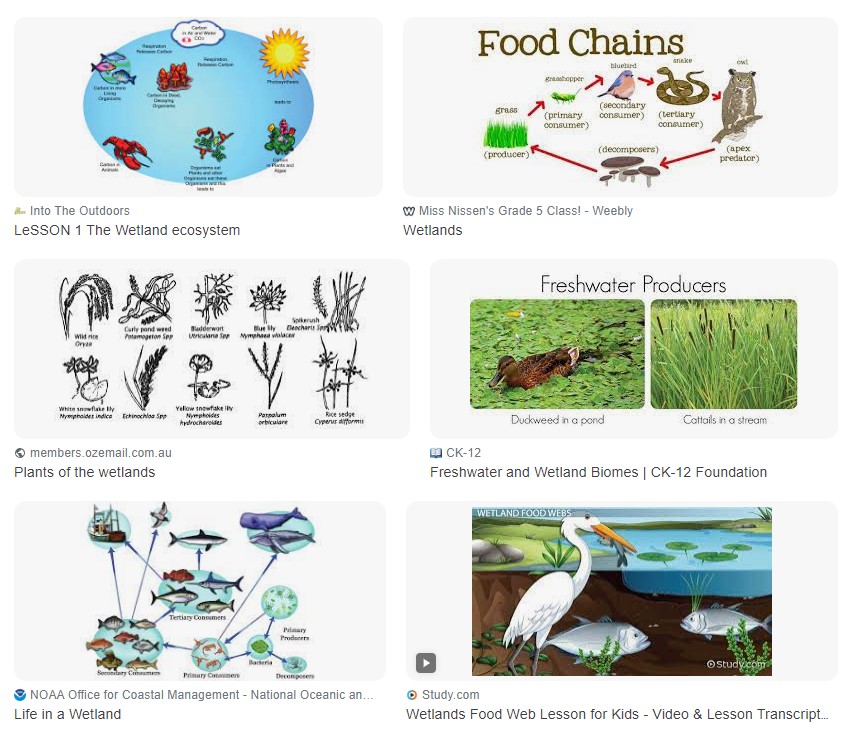The producers, or plants, in a wetland habitat incorporate rushes, mahogany trees, reeds, aquatic macrophytes and algae. Different wetland manufacturers are seagrasses, algae and mosses. The kinds of manufacturers in a wetland matter generally on the drainage, water and soil of the area.

In a wetland ecosystem, the producers are flora and algae. Wetland consumers can include marine and/or clean water invertebrates (shrimp, clams), fish, birds, amphibians, and mammals.
One can also ask, what are some significant clients in the wetlands? Examples of vital consumers in a wetland include insects, deer, and microorganisms (plankton). Secondary consumers feed on organisms who are significant consumers. In different phrases secondary clients consume these organisms who eat plants. Those organisms are in general known as carnivores because they devour meat.
What plants can you discover in wetlands?
They comprise timber together with swamp mahogany, swamp paperbark and swamp she-oak, and shrubs like the swamp banksia, tea timber and ferns. Saltmarshes characteristic vegetation which include pigface, sea rush, marine couch, creeping brookweed and swamp weed, all of which are adapted to saltier conditions.
What is the nutrition chain in the wetlands?
Definition of WetlandA wetland nutrients internet contains vegetation and animals that could live within the water, as well as vegetation and animals that feed along the perimeters of the water like the eagle and the fish.
Also read : What is command line tools?
Where can you uncover wetlands?
Wetlands are locations of land in which water covers the soil – all year or simply at sure times of the year. They include: swamps, marshes. billabongs, lakes, lagoons. saltmarshes, mudflats. mangroves, coral reefs. bogs, fens, and peatlands.
Where are wetlands such a lot common?
Wetlands exist in many types of climates, on every continent apart from Antarctica. They vary in size from remoted prairie potholes to very large salt marshes. They are discovered along coasts and inland. Some wetlands are flooded woodlands, filled with trees.
What are the features of a wetland?
A wetland is a unique surroundings that is flooded by means of water, either completely or seasonally, wherein oxygen-free approaches prevail. The first factor that distinguishes wetlands from other land varieties or water our bodies is the attribute plants of aquatic plants, tailored to the unique hydric soil.
What are some herbivores in the wetlands?
Most animals in wetlands are omnivores in that they will feed on whatsoever is available so so much animals in wetlands eat, at least, some plant material. Nutria, beavers, and muskrats are frequently herbivores but they are going to devour smaller animals if they’re conveniently available and which cannot aggressively shield themselves.
What do you imply by means of wetland?
Definition of wetland. : land or locations (such as marshes or swamps) which are blanketed often intermittently with shallow water or have soil saturated with moisture —usually utilized in plural.
What are some omnivores in the wetlands?
Examples of omnivores are: Bears –They devour insects, fish, moose, elk, deer, sheep in addition to honey, grass, and sedges. Turtles — They devour snails, crayfish, crickets, earthworms, but additionally lettuce, small plants, and algae. Monkeys — They consume frogs and lizards as well as fruits, flowers, and leaves.
Is algae a decomposer?
Energy in a foodstuff internet flows from manufacturers to consumers to decomposers. Plants and other manufacturers such as algae use those nutrients, which include carbon, nitrogen and minerals. Organisms that act as decomposers incorporate fungi, micro organism and other microbes. Scavengers devour useless animals and also are regarded consumers.
Do mosquitoes eat reeds?
Water boatmen eats algae and reeds. 3. Mosquito larvae also eat the algae. Mosquitoes consume plant nectar from bulrushes and reeds.
Do snakes stay within the wetlands?
There are usually strong ecological connections among wetlands in a landscape. Specifically tailored reptiles which are able swimmers usually are found in wetlands. These types of incorporate the typical snapping turtle, spotted turtle, northern water snake, cottonmouth snake, diamondback water snake and garter snakes.
What can you find in wetlands?
Swamps and Wetland Info Short Description: A quick clarification of this habitat Swamps and wetlands are areas wherein a big location of water is broken up by way of small islands of land and large amounts of plants. Animals Wetland: Regular animals found during this habitat Insects, Fish, Reptiles
Can you plant on wetlands?
More than 5,000 different vegetation develop in wetlands. Some regular wetland flora to look for include: Water lilies, cattails, arrowhead, smartweed, pondweed and other vegetation in standing water. Grasses together with reed canary grass, barnyard grass, and prairie cordgrass, or rushes and sedges.
How do vegetation live on in the wetlands?
Wetland vegetation are vegetation that have developed distinctive variations that let them to stay within the water. Some adaptations that assist the vegetation manage low oxygen and changing water degrees are elongated stems, shallow roots, aerenchyma and adventitious roots.
What are the advantages of wetlands?
Wetlands supply many societal benefits: nutrients and habitat for fish and wildlife, adding threatened and endangered species; water high quality improvement; flood storage; shoreline erosion control; economically beneficial healthy items for human use; and opportunities for recreation, education, and study (Figure 28)
What is the local weather of wetlands?
Wetlands in temperate climates event warm summers and cold winters. Wetlands in tropical climates may have temperatures as excessive as 122º F (50º C)! Wetlands be given various amounts of rain. Some wetlands take delivery of as little as 6 inches (15 cm) of rain every year.